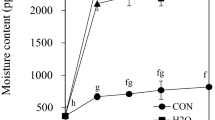Abstract
Effects of deuterium oxide and deuterium oxide-free water on the oxidative stability and formation of headspace volatiles were determined for corn oils to evaluate the role of moisture as an active influential factors during lipid oxidation. Mixtures of corn oil and water with different ratios of deuterium oxide were prepared, and the mixtures were stored at 60 °C for 2 days. Headspace oxygen contents, conjugated dienoic acid (CDA) values, and p-anisidine values (p-AV) were analyzed as a measure of oxidative stability, and headspace volatiles were analyzed by solid phase microextraction and a gas chromatography mass selective detector to determine the involvement of deuterium in volatiles. Deuterium oxide accelerated the rate of lipid oxidation in corn oil compared to oils with deuterium-free water based on the results of headspace oxygen content, CDA, p-AV, and total volatile content. Fragmented mass to charge ratios (m/z) of 73.1/72.1 for d 1-pentane/pentane and 57.0/56.0 for d 1-2-propenal/2-propenal from samples containing deuterium oxide were significantly higher than those from deuterium oxide-free water, implying that moisture participated to form volatiles in corn oil oxidation under air-tight condition. Deuterium oxide appeared to accelerate the rate of lipid oxidation in corn oils and participated to form volatiles from oils during oxidation.




Similar content being viewed by others
References
McClements DJ, Decker EA (2000) Lipid oxidation in oil-in-water emulsions: impact of molecular environment on chemical reactions in heterogeneous food systems. J Food Sci 65:1270–1282
Choe E, Min DB (2006) Mechanisms and factors for edible oil oxidation. Compr Rev Food Sci F 5:169–186
Chaiyasit W, Elias RJ, McClements DJ, Decker EA (2007) Role of physical structures in bulk oils on lipid oxidation. CRC Crit Rev Food Sci Nutr 47:299–317
Chaiyasit W, Stanley CB, Strey HH, McClements DJ, Decker EA (2007) Impact of surface active compounds on iron catalyzed oxidation of methyl linolenate in AOT–water–hexadecane systems. Food Biophys 2:57–66
Frankel EN, Huang SW, Kanner J, German JB (1994) Interfacial phenomena in the evaluation of antioxidants: bulk oils vs emulsions. J Agric Food Chem 42:1054–1059
Schwarz K, Huang SW, German JB, Tiersch B, Hartmann J, Frankel EN (2000) Activities of antioxidants are affected by colloidal properties of oil-in-water and water-in-oil emulsions and bulk oils. J Agric Food Chem 48:4874–4882
Chen B, Panya A, McClements DJ, Decker EA (2012) New insights into the role of iron in the promotion of lipid oxidation in bulk oils containing reverse micelles. J Agric Food Chem 60:3524–3532
Mei LY, Decker EA, McClements DJ (1998) Evidence of iron association with emulsion droplets and its impact on lipid oxidation. J Agric Food Chem 46:5072–5077
Kim JY, Park JW, Kim MJ, Lee JH (2013) Role of moisture on the lipid oxidation determined by D2O in linoleic acid system. Food Chem 146:134–140
Lee JH, Min DB (2009) Effects of photo oxidation and chlorophyll photosensitization on the formation of volatile compounds in lard model systems. Food Sci Biotechnol 18:413–418
AOCS (2006) Official methods and recommended practices of the American Oil Chemists’ Society, 4th edn. AOCS press, Champaign
Decker EA, Warner K, Richards MP, Shahidi E (2005) Measuring antioxidant effectiveness in food. J Agric Food Chem 53:4303–4310
Laguerre M, Lecomte J, Villeneuve P (2007) Evaluation of the ability of antioxidants to counteract lipid oxidation: existing methods, new trends and challenges. Prog Lipid Res 46:244–282
Yeo JD, Park JW, Lee JH (2011) Evaluation of antioxidant capacity of sesamol in lard model systems with different oxidation temperature. Eur J Lipid Sci Technol 113:910–915
Kim TS, Decker EA, Lee JH (2012) Antioxidant capacities of α-tocopherol, trolox, ascorbic acid, and ascorbyl palmitate in riboflavin photosensitized O/W emulsion systems. Food Chem 133:68–75
Lee JM, Chung H, Chang PS, Lee JH (2007) Development of a method predicting the oxidative stability of edible oils using 2,2-diphenyl-1-picrylhydrazyl (DPPH). Food Chem 103:662–669
Lee JM, Kim DH, Chang PS, Lee JH (2007) Headspace-solid phase microextraction (HS-SPME) analysis of oxidized volatiles from free fatty acids (FFA) and application for measuring hydrogen donating antioxidant activity. Food Chem 103:414–420
Yang SO, Lee JM, Lee JC, Lee JH (2007) Effects of riboflavin-photosensitization on the formation of volatiles in linoleic acid model systems with sodium azide or D2O. Food Chem 105:1375–1381
Frankel EN (1985) Chemistry of autoxidation: mechanism, products and flavor significance. In: Min DB, Smouse TH (eds) Flavor chemistry of fats and oils. AOCS Press, Champaign, pp 1–37
Frankel EN, Neff WE, Selke E (1981) Analysis of autoxidized fats by gas chromatography mass spectrometry VII volatile thermal decomposition products of pure hydroperoxides from autoxidized and photosensitized oxidized methyl oleate, linoleate and linolenate. Lipids 16:279–285
Frankel EN, Huang SW, Kanner J, German JB (1994) Interfacial phenomena in the evaluation of antioxidants: bulk oil vs emulsion. J Agric Food Chem 42:1054–1059
Lee JH, Decker EA (2011) Effects of metal chelators, sodium azide, and superoxide dismutase (SOD) on the oxidative stability in riboflavin photosensitized O/W emulsion systems. J Agric Food Chem 59:6271–6276
Jeong MK, Lee JM, Lee JH (2010) Correlation of volatiles and fatty acids in thermally oxidized fatty acid model systems using statistical approaches. Food Sci Biotechnol 19:1233–1239
Hofstetter TB, Schwarzenbach RP, Bernasconi SM (2008) Assessing transformation processes of organic compounds using stable isotope fractionation. Environ Sci Technol 42:7737–7743
Chen B (2012) Minor components and their roles on lipid oxidation in bulk oil that contains association colloids. Ph.D. Dissertation. U Mass, Amherst
Nawar WW (1996) Lipids. In: Fennema OR (ed) Food chemistry. Marcel Dekker, New York, pp 225–319
Acknowledgments
This research was supported by the Basic Science Research Program through the National Research Foundation of Korea (NRF) [NRF-2012R1A1A2039387] funded by the Ministry of Education, Science and Technology.
Author information
Authors and Affiliations
Corresponding author
About this article
Cite this article
Kim, J., Kim, MJ. & Lee, J. Effects of Deuterium Oxide on the Oxidative Stability and Change of Headspace Volatiles of Corn Oil. J Am Oil Chem Soc 91, 623–628 (2014). https://doi.org/10.1007/s11746-013-2398-6
Received:
Revised:
Accepted:
Published:
Issue Date:
DOI: https://doi.org/10.1007/s11746-013-2398-6



